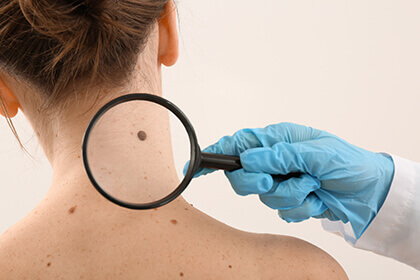
Types of Skin Cancer
Actinic keratoses (AK) small patches or lesions are typically present in earliest stage of skin cancer development. These small, scaly spots typically occur on the face, ears, neck, scalp, hands, arms and legs of people who have experienced significant sun exposure. AKs can form above or below the skin’s surface, are only a few millimeters in size, and can be flat or raised. They are typically harmless, but 20% of them are likely to become cancerous. surface as visible ones.
Basal cell carcinoma (BCC) is the most common type of skin cancer and typically appears on the head, neck and hands as a small, fleshy bump, nodule or red patch. These slow-growing tumors do not spread to other areas of the body, but if left untreated they often begin to bleed, crust over, heal and repeat the cycle. Basal cell carcinoma can also extend below the skin to bones and nerves, causing considerable local damage.
Squamous cell carcinoma (SCC) is the second most common skin cancer and typically appears as a bump or red, scaly patch on the face, lips, mouth or rim of the ear. Squamous cell carcinoma can invasively develop into large masses, then spread to other parts of the body.
Malignant melanoma is the most deadly of all skin cancers, but is completely curable when treated early. Melanoma tumors grow from melanocytes—cells that make pigment in the skin—and are typically tan, brown, black, white or even red. Melanoma may appear suddenly or begin in or near a mole or other dark spot in the skin. It’s important to be aware of the locations and appearance of moles on the body to detect changes as early as possible.
Skin Cancer Surgery and Removal in Long Beach
There are a variety of skin cancer surgery procedures to consider based on your type of cancer and how much it has spread. The most common skin cancers are referred to as “nonmelanoma skin cancers” and are slow growing and easily treatable.
Mohs Surgery
The most common surgical procedure for treatment of nonmelanoma skin cancers is Mohs surgery. Also referred to as chemosurgery, the cure rate is very high – 98% or greater for both basal cell and squamous cell carcinomas.
Mohs surgery is a four-step process that entails surgically removing sections of tissue, examining each specimen, mapping the cancerous areas and – when all cancerous cells have been removed – performing reconstructive surgery.
Melanoma is the deadliest form of skin cancer. As mentioned above, it is important to be aware of miles on the body and watch for any changes. With early detection in some cases only the mole and immediate surrounding area need removal. However surgery may be required to remove the primary melanoma as well as any cancerous lymph nodes. Surgical procedures to treat melanoma include local excision, wide local excision, lymph node dissection and sentinel lymph node biopsy.
Cure rates vary widely and are largely dependent upon how early melanoma is detected and how far it has metastasized in the body.
Eyelid Cancer, Tumors, and Eyelid Reconstruction
Basal cell carcinoma is the most common cancer to affect the eyelid is. This type of cancer is often caused by exposure to ultraviolet light. The majority of cancers of the eyelid are easily treatable when identified and early by a medical professional.
Oculoplastic surgeons are uniquely trained to reconstruct eyelids after an eyelid tumor has been removed. At Eye Physicians of Long Beach, our goal is complete removal of the disease and eyelid repair that is as aesthetically pleasing as possible.
If you are concerned about a bump on your eyelid or an irregular lesion, call Eye Physicians of Long Beach for an eye examination. Our Long Beach cosmetic and oculoplastic surgeons specialize in the removal of skin cancers and the reconstruction of eyelids from eyelid cancer.
